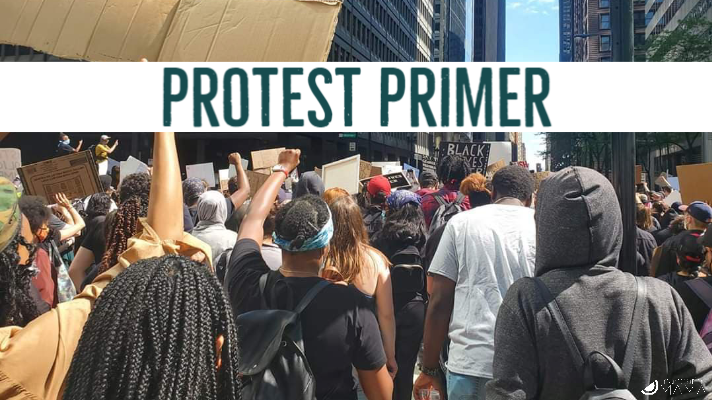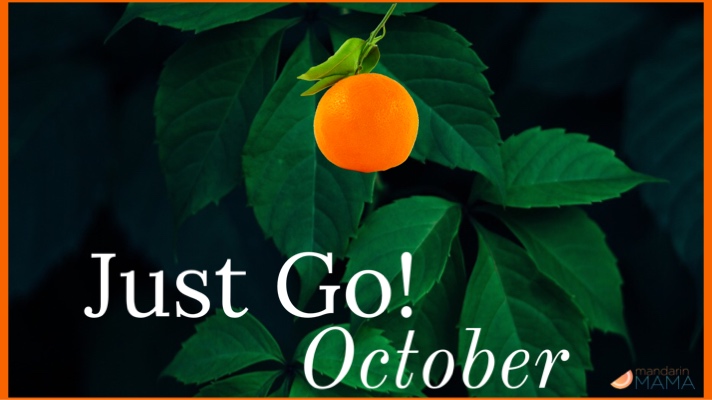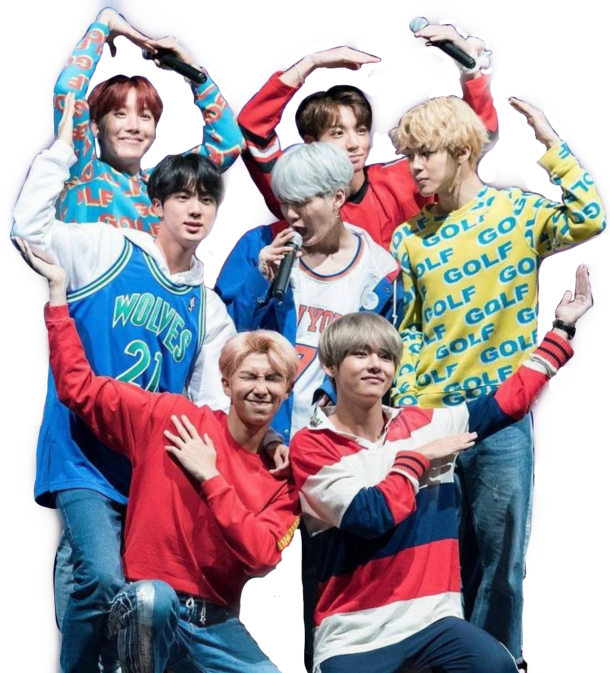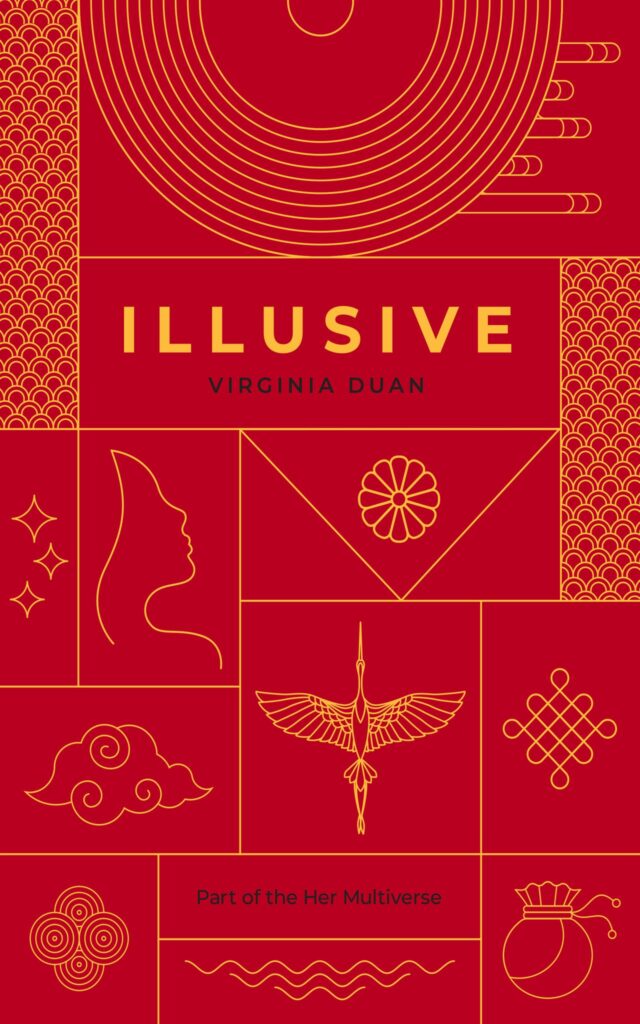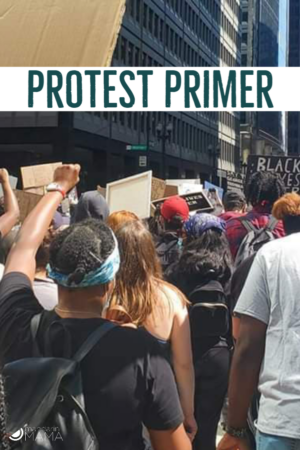
Today, we have a guest post by my friend, Edward Vere Walrod. Ed (he/him/they/them) is an avocado hating millennial Korean American originally from Seoul and is now in Chicago working in communications and digital media. He is an aggressive PCUSA Presbyterian with a low tolerance for BS, conservatism, and a sushi-kbbq-boba addiction that will most likely kill him and the world’s oceans one day. He is truly grateful that the biggest theological influences in his life are amazing women (s/o to PAAC).
[Content Warning]: Violence, Ableism, Racism
Folks all over the world are on the street for Black Lives Matter Protests. Some of us are familiar with the world of organizing and protests. For others, this might be an unfamiliar form of activism and community participation. In this article, we’ll give a primer on participating in protests: things you should consider, and guidelines on what to do once you get there.
My own first experiences with protests were in college, as I was deconstructing my own faith, racial and ethnic identity, and sexuality. Since then, I’ve continued to participate in protests as a concrete expression of my values and my faith. I’m not a professional organizer, but in this article, I’ve collected advice that I’ve learned from organizers and activists from current and past movements.
In this article, we will discuss what protests are, and how to ascertain the safety and legitimacy of a protest being promoted. We’ll be covering different reasons why protesting may not be the best direct action for you. Finally, we’ll give a primer on what to do once you get to the protest.
What is a protest?
First, a quick note on what protests are.
Protesting is a form of mutual aid: disrupting the status quo, fueling action that transforms policies and systems. Protesting is an act of solidarity: centering the voices of the oppressed and physically demanding justice. A protest is a body, and your individual actions have consequences for the whole.
Assessing the legitimacy of an event
Not every protest is organized by justice-seeking groups.The legitimacy of a protest is determined by the organizers. If a protest is organized by organizers or for a just cause they will not hide who they are or information surrounding their identity. Recently, there has been an increase in fake protests created to bait justice-oriented protesters into breaking laws, cornering them in unsavory situations, or simply for enterprising folks to build their own brands. These three questions aren’t hard-and-fast rules, but good ways to gut-check what’s going on with an event.
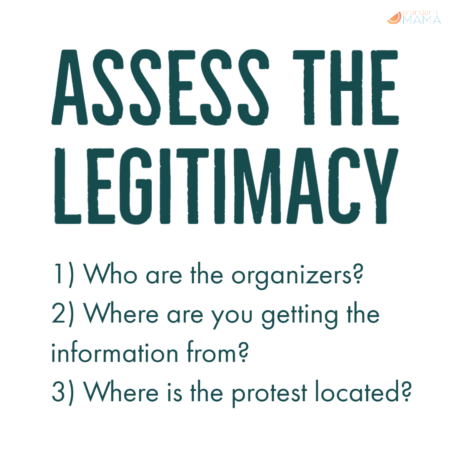
1. Who are the organizers?
Look for: Protests organized by seasoned organizers, mutual aid networks, and nonprofits, such as Black Lives Matter.
Red flags: If the organizers will not disclose their identities and affiliations, stay away and report them to organizations such as the American Civil Liberties Union, Southern Poverty Law Center, and Black Lives Matter. If anything about the event seems suspicious or off, look more deeply into the organizers’ and affiliate organizations’ social media.
2. Where are you getting the information from?
Look for: Official pages or well-organized groups that disseminate information. If you can trace the protests back to these pages or groups, they are most likely legitimate.
Red flags: If the pages or organizing groups have no history prior to the event, of if there is no public presence at all.
3. Where is the protest located?
Look for: Most protests, even if kept secret until a few hours before the meeting time, begin in larger and open public areas.
Red flags: Alleys, enclosed spaces, or cul-de-sac-like settings are often traps to surround and entrap protesters.
When not to protest
It’s also important to consider that protesting may not always be the safest form of activism for you to participate in. Consider these factors as you make your decision.
- Your immigration status: Protesters are at risk of arrest, and non-citizens of the United States face potential deportation.
- Personal health: Protests can be a risky place for folks with medical conditions and folks with disabilities. Access to medical care may be tricky, and the physical environment may not be predictable or accessible.
- People close to you: Your risk of injury, incarceration, and contracting COVID-19 may have serious implications for the well-being of your household, family, friends, and others you interact with normally.
- Experience: The tone of a protest can vary a lot, and organizers are often clear about the potential for “sticky” situations such as police confrontations. Pay close attention to the general feeling of the crowd, as well as the organizer’s advice on the protest before deciding to attend.
- Other: There are many other reasons that may not lend yourself to going to a protest, and other ways to participate in movements towards liberation.
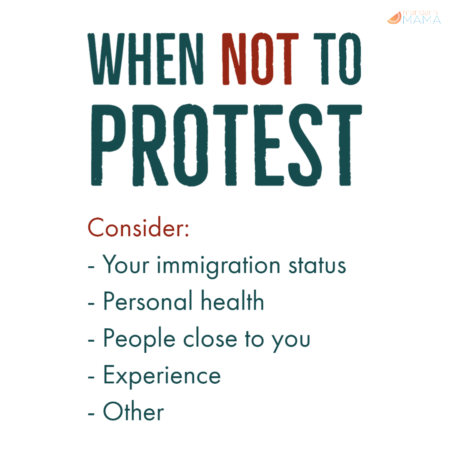
what to do once you get to the protest
My first protests were in largely peaceful settings on college campuses, but these experiences left me ill-equipped for larger, more public protests. Based on my experiences since and advice I’ve learned, I now always prepare and do the following before, during, and after a protest.
What types of signs should I bring?
Signs are visible displays of solidarity with a crowd meant to draw attention to actions, ideas, or capture the attention of others to bring an issue to light. Consider this:
-
- Center the message and/or the marginalized group of the protest.
- When in doubt, go with a sponsoring organization’s message or slogan
- Make sure it is large and clear enough for others to see
- If the organizers predict potential police brutality, signs on 1-inch thick plywood or metal trash can lids can help stop rubber bullets
What types of supplies should I consider?
This is neither a comprehensive or a mandatory list. Be sure to check your organizer’s recommendations.
- Comfortable backpack with:
- Extra clothes
- Water
- High-protein snacks
- Band-aids and gauze
- A vinegar-soaked bandana (for tear gas)
- A small umbrella (for weather and tear gas).
- Helmet and safety goggles
- Burner Phone with the following:
- Emergency contacts
- Encrypted messaging apps (like Signal or Telegram)
Safety Considerations
While protests come with risks, you can minimize some of the biggest ones with a few simple steps. Each protest may be different depending on the situation, especially in the context of police brutality and COVID-19.
Emergency Contacts: Have 3 or more emergency contacts who are located in close proximity to the protest you are attending. Emergency contacts can help provide shelter, bail funds, or updates on police activities. Always ask for consent and give them a heads up before you go out!
COVID-19 Safety Protests are often crowded. Always wear a face mask and wash and or disinfect your hands as much as possible. Bathe afterward if possible. Consider not attending if you are immunocompromised, and do not attend if you tend to or are in close proximity with immunocompromised folks.
Anonymous Messaging Apps Your messages and other data on your phone are easily tracked by the police. Apps like Signal provide extra levels of precaution, security, and anonymity. It is best to also have your emergency contacts download these apps to communicate with you.
Protest Best Practices
Protests only work if everyone is on the same page. Disorganization or disunity of messaging can confuse protest goers and onlookers and cause agitation.
Do:
-
- Listen to the organizers and “line leaders.” Protests organized by organizers or organizations will typically disseminate information and instructions constantly. Listen to all of it and follow it. They are meant to keep you safe and organized. Line leaders are organizers put in charge of different sections of the protest and will often be the ones starting chants or giving directions.
- Stay behind the main banners/organizers.
- If you see police misbehavior or maneuvering themselves behind or near protestors, warn your fellow protestors and record the behavior.
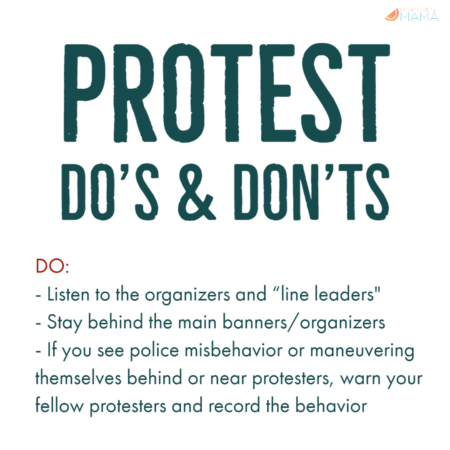
Do not:
-
- Stray from the main group other than to go home. Do not stray from the main group unless told by the organizers. This is often a tactic to separate the protests into several small groups.
- Take space, interviews, or speeches from the organizers or marginalized voices away from the communities the protests are centering, unless given explicit permission by the organizers.
- Chant slogans or hold up signs that de-center the voices of the communities the protests are about.
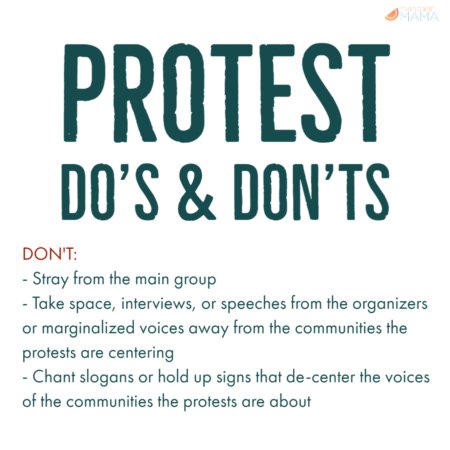
In Conclusion…
All protests come with risks to weigh. For me, physical protests are one way I co-conspire in justice and follow in the footsteps of those who came before me. If you choose to participate, follow and listen to those who have already been organizing, and take precautions for your own safety and for those around you. Stay safe and comment if you have questions!

